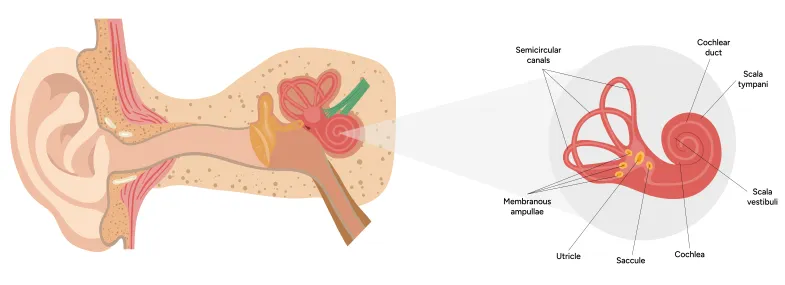When the tense pursuit of "Hot Pursuit" turned into a nauseating curse, and the magnificent vistas of "Soarin' Around the World" became a nightmare of spinning vertigo, Xiao Wen slumped on a Disney bench, finally confronting a harsh reality:
she was allergic to the "Happiest Place on Earth"!
This wasn't hypersensitivity or timidity. It was her deeply hidden inner-ear organ –
the vestibular system – staging a vehement protest, trapping countless children and adults yearning for fairy tales in the dilemma of "wanting to play but not daring to."
1. The Inner Ear's "Biological Gyroscope"
Deep within the inner ear of each person lies a sophisticated
vestibular system. This system, comprising
three semicircular canals and
two otolith organs (the
utricle and
saccule), is responsible for sensing head position, movement speed, and direction. It is the core structure for maintaining
balance and
spatial orientation.
Xiao Wen's "happiness allergy" was actually a manifestation of
vestibular sensitivity. This occurs when the vestibular system exhibits an abnormally intense reaction to normal motion stimuli, resulting in excessive
dizziness,
disequilibrium, or
nausea in response to minor head movements or changes in posture.
Imagine soaring upwards in a Soarin' seat: the
endolymph fluid within the semicircular canals flows with the direction of motion, while the otolith organs detect body tilt angles through
crystal displacement. The brain integrates this information to coordinate balance.
However, for those with vestibular sensitivity, the body sends conflicting alarms: the eyes report "We're flying!", while the vestibular system insists "You're sitting still!" This sensory mismatch overwhelms the brain, leading to systemic distress.
 2. The Misunderstood "Cowards"
2. The Misunderstood "Cowards"
Amidst the joyful chaos of an amusement park, while other children laughingly dash towards spinning teacups or eagerly climb aboard Tron Lightcycle Power Run, a few small figures often cling tightly to their parents' clothes, seeming timid. These children labeled "cowardly" are likely also victims of
vestibular sensitivity.
Children are in a phase of rapid growth and development. Their vestibular system requires a prolonged maturation process after birth, only reaching near-adult levels around age 6. This specific physiological characteristic makes children more sensitive to vestibular stimuli and more prone to vestibular sensitivity symptoms. This often manifests as negative emotions like avoidance, irritability, or even tantrums.
More concerningly, this sensitivity often forms a vicious developmental cycle:
Fear of dizziness leads to
avoidance of movement →
Motor skill development lags behind peers →
Repeated
frustration in group games →
Development of
inferiority complex →
Increased
resistance to participating in physical activities.
Long-term, this cycle can significantly hinder a child's physical and mental health, as well as their social skills.
3. Gradual Progress: Rebuilding Vestibular Tolerance
Vestibular sensitivity is not exaggerated sensitivity; it is a genuine neurological warning signal. If experiencing
persistent vertigo,
nausea and vomiting,
double vision,
severe headache, or
balance impairment preventing normal walking, it is crucial to immediately stop the stimulating activity, allow the body time to recover, and seek medical attention promptly.
For individuals with vestibular sensitivity,
gradual physical training is key to rebuilding balance function. For someone like Xiao Wen experiencing discomfort at Disney, starting with gentler park rides allows for
progressive exposure therapy, helping the vestibular system safely build tolerance step-by-step.
For vestibular training in infants and toddlers, the
"airplane" game is a gentle and effective starting point. Position the baby prone on the caregiver's sturdy forearm and move slowly like an airplane taking off. This provides optimal vestibular stimulation while promoting head, neck, and spine extension development.
Under the guidance of a medical professional,
pharmacological intervention can sometimes be used adjunctively to reduce vestibular sensitivity. However, vestibular recovery is a process requiring patience. Respecting the body's responses and progressing gradually yields the best results.
Happiness Wears Many Faces
The meaning of the "Happiest Place on Earth" isn't about conquering thrills, but about
finding your own rhythm of joy.
May every child and adult with a sensitive constitution find their own way to embrace happiness this Children's Day,
crafting their own unique fairy tales.
